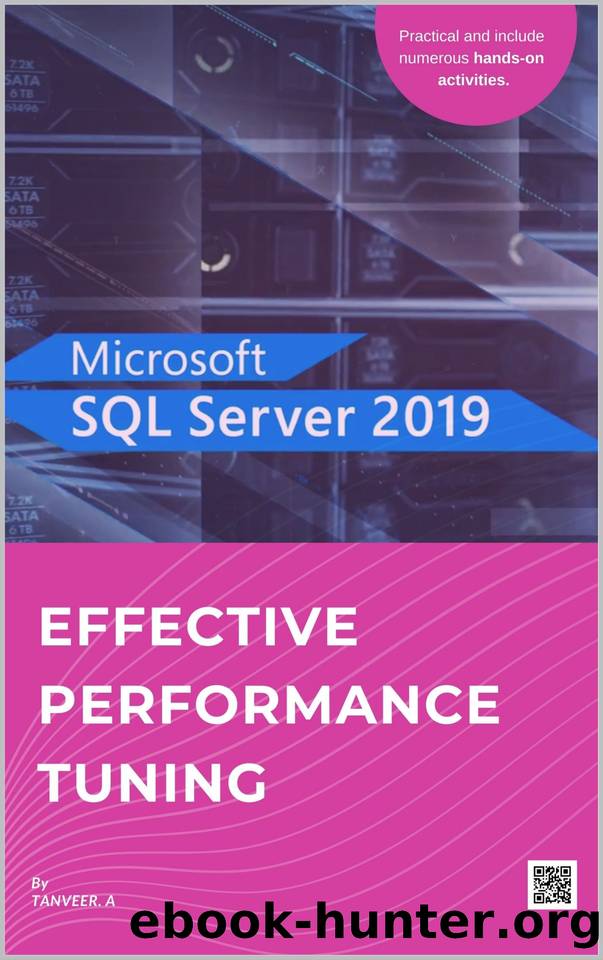SQL Server 2019 Effective Performance Tuning: SQL Server Simplified by A Tanveer

Author:A, Tanveer [A, Tanveer]
Language: eng
Format: epub
Publisher: UNKNOWN
Published: 2021-01-29T16:00:00+00:00
If at a later date there is a need to roll back on a proposed optimization, then select the relevant query and select Rollback . That query plan guide is removed and the list updated to remove the rolled back query. Note in the picture below that query 8 was removed.
Resource Governor
SQL Server Resource Governor is a feature that you can use to manage SQL Server workload and system resource consumption. Resource Governor enables you to specify limits on the amount of CPU, physical I/O, and memory that incoming application requests can use.
Benefits of Resource Governor
Resource Governor enables you to manage SQL Server workloads and resources by specifying limits on resource consumption by incoming requests. In the Resource Governor context, workload is a set of similarly sized queries or requests that can, and should be, treated as a single entity. This is not a requirement, but the more uniform the resource usage pattern of a workload is, the more benefit you are likely to derive from Resource Governor. Resource limits can be reconfigured in real time with minimal impact on workloads that are executing.
In an environment where multiple distinct workloads are present on the same server, Resource Governor enables you to differentiate these workloads and allocate shared resources as they are requested, based on the limits that you specify. These resources are CPU, physical I/O, and memory.
By using Resource Governor, you can:
⢠Provide multitenancy and resource isolation on single instances of SQL Server that serve multiple client workloads. That is, you can divide the available resources on a server among the workloads and minimize the problems that can occur when workloads compete for resources.
⢠Provide predictable performance and support SLAs for workload tenants in a multiworkload and multi-user environment.
⢠Isolate and limit runaway queries or throttle I/O resources for operations such as DBCC CHECKDB that can saturate the I/O subsystem and negatively impact other workloads.
⢠Add fine-grained resource tracking for resource usage chargebacks and provide predictable billing to the consumers of the server resources.
Resource Governor Constraints
This release of Resource Governor has the following constraints:
⢠Resource management is limited to the SQL Server Database Engine. Resource Governor cannot be used for Analysis Services, Integration Services, and Reporting Services.
⢠There is no workload monitoring or workload management between SQL Server instances.
⢠Resource Governor can manage OLTP workloads but these types of queries, which are typically very short in duration, are not always on the CPU long enough to apply bandwidth controls. This may skew in the statistics returned for CPU usage percent.
⢠The ability to govern physical I/O only applies to user operations and not system tasks. System tasks include write operations to the transaction log and Lazy Writer I/O operations. The Resource Governor applies primarily to user read operations because most write operations are typically performed by system tasks.
⢠You cannot set I/O thresholds on the internal resource pool.
Resource Concepts
The following three concepts are fundamental to understanding and using Resource Governor:
⢠Resource pools. A resource pool, represents the physical resources of the server.
Download
This site does not store any files on its server. We only index and link to content provided by other sites. Please contact the content providers to delete copyright contents if any and email us, we'll remove relevant links or contents immediately.
| Access | Data Mining |
| Data Modeling & Design | Data Processing |
| Data Warehousing | MySQL |
| Oracle | Other Databases |
| Relational Databases | SQL |
Algorithms of the Intelligent Web by Haralambos Marmanis;Dmitry Babenko(16234)
Azure Data and AI Architect Handbook by Olivier Mertens & Breght Van Baelen(7674)
Building Statistical Models in Python by Huy Hoang Nguyen & Paul N Adams & Stuart J Miller(7655)
Serverless Machine Learning with Amazon Redshift ML by Debu Panda & Phil Bates & Bhanu Pittampally & Sumeet Joshi(7529)
Driving Data Quality with Data Contracts by Andrew Jones(7293)
Data Wrangling on AWS by Navnit Shukla | Sankar M | Sam Palani(7290)
Machine Learning Model Serving Patterns and Best Practices by Md Johirul Islam(7030)
Learning SQL by Alan Beaulieu(6237)
Weapons of Math Destruction by Cathy O'Neil(6214)
Big Data Analysis with Python by Ivan Marin(5933)
Data Engineering with dbt by Roberto Zagni(4931)
Solidity Programming Essentials by Ritesh Modi(4565)
Time Series Analysis with Python Cookbook by Tarek A. Atwan(4399)
Pandas Cookbook by Theodore Petrou(4086)
Blockchain Basics by Daniel Drescher(3540)
Natural Language Processing with Java Cookbook by Richard M. Reese(3143)
Hands-On Machine Learning for Algorithmic Trading by Stefan Jansen(3043)
Learn T-SQL Querying by Pam Lahoud & Pedro Lopes(2930)
Feature Store for Machine Learning by Jayanth Kumar M J(2925)
